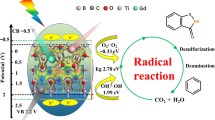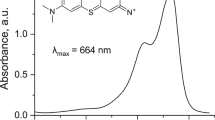Abstract
The presence of imidacloprid in surface waters has raised major environmental concern worldwide. Herein, for degradation and mineralization of imidacloprid, hybrid nano-catalysts g-C3N4/ZnO (< 20 nm) with different compositions were synthesized and characterized. Under UV-C light intensity of 15 W/m2 and at pH 7, degradation was observed to be highest (95.6%) for g-C3N4/ZnO (20:80) in comparison to bare ZnO (80.6%) and g-C3N4 (84.1%) nano-catalysts in just 35 min. The remarkable increase in photocatalytic activity was due to improved surface area (42.87 m2g−1), lower bandgap (2.76 eV) and lower photoluminescence intensity which resulted in lowering the recombination rate of electron–hole charge carriers. Further, higher zeta potential (+28 mV) at pH 7 might have increased intimacy in positively charged catalyst and high electron rich aromatic ring of imidacloprid which enhanced the degradation. The study was extended to analyze the reaction intermediates using LC–MS. The degradation mechanism revealed the formation of by-products such as ethylenediamine, nitroamine, acrolein, CO2 and H2O. Overall, g-C3N4/ZnO (20:80) was found to be a promising catalyst for the degradation of imidacloprid at neutral pH.










Similar content being viewed by others
References
Agüera A, Almansa E, Malato S et al (1998) Evaluation of photocatalytic degradation of imidacloprid in industrial water by GC-MS and LC-MS. Analusis 26:245–251. https://doi.org/10.1051/analusis:1998168
Benotti MJ, Stanford BD, Wert EC, Snyder SA (2009) Evaluation of a photocatalytic reactor membrane pilot system for the removal of pharmaceuticals and endocrine disrupting compounds from water. Water Res 43:1513–1522. https://doi.org/10.1016/j.watres.2008.12.049
Berheim EH, Jenks JA, Lundgren JG et al (2019) Effects of neonicotinoid insecticides on physiology and reproductive characteristics of captive female and fawn white-tailed deer. Sci Rep 9:1–10. https://doi.org/10.1038/s41598-019-40994-9
Chen S, Deng J, Deng Y, Gao N (2019) Influencing factors and kinetic studies of imidacloprid degradation by ozonation. Environ Technol 40:2127–2134. https://doi.org/10.1080/09593330.2018.1439105
Derbalah A, Sunday M, Chidya R, Jadoon W, Sakugawa H (2019) Kinetics of photocatalytic removal of imidacloprid from water by advanced oxidation processes with respect to nanotechnology. J Water Health 17:254–265. https://doi.org/10.2166/wh.2019.259
Ding T, Jacobs D, Lavine BK (2011) Liquid chromatography-mass spectrometry identification of imidacloprid photolysis products. Microchem J 99:535–541. https://doi.org/10.1016/j.microc.2011.07.005
Feng C, Xu G, Liu X (2013) Photocatalytic degradation of imidacloprid by composite catalysts H3PW12O40/La-TiO2. J Rare Earth 31:44–48. https://doi.org/10.1016/S1002-0721(12)60232-4
Fenoll J, Garrido I, Hellín P, Flores P, Navarro S (2015) Photodegradation of neonicotinoid insecticides in water by semiconductor oxides, Environ. Sci Pollut R 22:15055–15066. https://doi.org/10.1007/s11356-015-4721-2
Grover IS, Singh S, Pal B (2014) Photodegradation of imidacloprid insecticide by Ag-deposited titanate nanotubes: a study of intermediates and their reaction pathways. J Agric Food Chem 62:12497–12503. https://doi.org/10.1021/jf5041614
Ismael M (2020) The photocatalytic performance of the ZnO/g-C3N4 composite photocatalyst toward degradation of organic pollutants and its inactivity toward hydrogen evolution: the influence of light irradiation and charge transfer. Chem Phys Lett 739:136992. https://doi.org/10.1016/j.cplett.2019.136992
Jo WK, Selvam NCS (2015) Enhanced visible light-driven photocatalytic performance of ZnO-g-C3N4 coupled with graphene oxide as a novel ternary nanocomposite. J Hazard Mater 299:462–470. https://doi.org/10.1016/j.jhazmat.2015.07.042
Kanwal M, Tariq SR, Chotana GA (2018) Photocatalytic degradation of imidacloprid by Ag-ZnO composite. Environ Sci Pollut Res 25:27307–27320. https://doi.org/10.1007/s11356-018-2693-8
Kitsiou V, Filippidis N, Mantzavinos D, Poulios I (2009) Heterogeneous and homogeneous photocatalytic degradation of the insecticide imidacloprid in aqueous solutions. Appl Catal B Environ 86:27–35. https://doi.org/10.1016/j.apcatb.2008.07.018
Komel T, Fabjan J, Bavcon M, Trebše P (2012) Photocatalytic degradation with immobilised TiO2 of three selected neonicotinoid insecticides: imidacloprid, thiamethoxam and clothianidin. Chemosphere 89:293–301. https://doi.org/10.1016/j.chemosphere.2012.04.039
Kong J, Zhai H, Zhang W, Wang X, Zhao X et al (2017) Visible light-driven photocatalytic performance of N-doped ZnO/g-C3N4 nanocomposites, Nanoscale Res Lett. 12:526–535. https://doi.org/10.1186/s11671-017-2297-0
Kumaresan N, Angelin MM, Kumar MP et al (2020) Investigation on the g-C3N4 encapsulated ZnO nanorods heterojunction coupled with GO for effective photocatalytic activity under visible light irradiation. Arab J Chem 13:2826–2843. https://doi.org/10.1016/j.arabjc.2018.07.013
Liao G, Chen S, Quan X et al (2012) Graphene oxide modified g-C3N4 hybrid with enhanced photocatalytic capability under visible light irradiation. J Mater Chem 22:2721–2726. https://doi.org/10.1039/c1jm13490f
Liu X, Wu X, Long Z et al (2015) Photodegradation of Imidacloprid in aqueous solution by the metal- free catalyst graphitic carbon nitride using an energy-saving lamp. J Agric Food Chem 63:4754–4760. https://doi.org/10.1021/acs.jafc.5b01105
Liu L, Luo X, Li Y et al (2018) Facile synthesis of few-layer g-C3N4/ZnO composite photocatalyst for enhancing visible light photocatalytic performance of pollutants removal. Colloids Surf A 537:516–523. https://doi.org/10.1016/j.colsurfa.2017.09.051
Malato S, Blanco J, Cáceres J, Fernández-alba AR (2002) Photocatalytic treatment of water-soluble pesticides by photo-Fenton and TiO2 using solar energy. Catal Today 76:209–220. https://doi.org/10.1016/S0920-5861(02)00220-1
Patil AL, Patil PN, Gogate PR (2014) Degradation of imidacloprid containing wastewaters using ultrasound based treatment strategies. Ultrason Sonochem 21:1778–1786. https://doi.org/10.1016/j.ultsonch.2014.02.029
Paul DR, Gautam S, Panchal P et al (2020) ZnO-modified g-C3N4: a potential photocatalyst for environmental application. ACS Omega. 5:3828–3838. https://doi.org/10.1021/acsomega.9b02688
Rong X, Qiu F, Jiang Z et al (2016) Preparation of ternary combined ZnO-Ag2O/porous g-C3N4 composite photocatalyst and enhanced visible-light photocatalytic activity for degradation of ciprofloxacin. Chem Eng Res Des 111:253–261. https://doi.org/10.1016/j.cherd.2016.05.010
Shorgoli AA, Shokri M (2017) Photocatalytic degradation of imidacloprid pesticide in aqueous solution by TiO2 nanoparticles immobilized on the glass plate. Chem Eng Commun 204:1061–1069. https://doi.org/10.1080/00986445.2017.1337005
Simsek UB, Turabik M (2018) Degradation of imidacloprid in aqueous solutions by zero valent iron nanoparticles in the nitrogen medium. Desalin Water. Treat. 114:341–355. https://doi.org/10.5004/dwt.2018.22355
Soltani-nezhad F, Saljooqi A, Shamspur T, Mostafavi A (2019) Photocatalytic degradation of imidacloprid using GO/Fe3O4/TiO2-NiO under visible radiation: optimization by response level method. Polyhedron 165:188–196. https://doi.org/10.1016/j.poly.2019.02.012
Tang J, Huang X, Huang X, Xiang L, Wang Q (2012) Photocatalytic degradation of imidacloprid in aqueous suspension of TiO2 supported on H-ZSM-5. Environ Earth Sci 66:441–445. https://doi.org/10.1007/s12665-011-1251-1
Wamhoff H, Schneider V (1999) Photodegradation of Imidacloprid. J. Agri. Food Chem. 47:1730–1734. https://doi.org/10.1021/jf980820j
Wang J, Yang Z, Gao X et al (2017) Core-shell g-C3N4@ZnO composites as photoanodes with double synergistic effects for enhanced visible-light photoelectrocatalytic activities. Appl Catal B 217:169–180. https://doi.org/10.1016/j.apcatb.2017.05.034
Wong MJ, Liao LH, Berenbaum MR (2018) Biphasic concentration-dependent interaction between imidacloprid and dietary phytochemicals in honey bees (Apis mellifera). PLoS ONE 13:1–15. https://doi.org/10.1371/journal.pone.0206625
Yari K, Seidmohammadi A, Khazaei M et al (2019) A comparative study for the removal of imidacloprid insecticide from water by chemical-less UVC, UVC/TiO2 and UVC/ZnO processes. J. environ. health sci. 17:337–351. https://doi.org/10.1007/s40201-019-00352-3
Zhang D, Liang S, Yao S et al (2020) Highly efficient visible/NIR photocatalytic activity and mechanism of Yb3+/Er3+ co-doped Bi4O5I2 up-conversion photocatalyst. Sep Purif Technol 248:117040. https://doi.org/10.1016/j.seppur.2020.117040
Zheng W, Liu W (1999) Kinetics and mechanism of the hydrolysis of imidacloprid. Pestic Sci 55:482–485. https://doi.org/10.1002/(SICI)1096-9063(199904)55:4%3c482:AID-PS932%3e3.0.CO;2-3
Acknowledgement
Authors are thankful to MRC Malaviya National Institute of Technology Jaipur for assistance in analysis of samples. Authors are also very thankful to Dr. Nirmal Singh Sekhon, Head Post Graduate Department of Chemistry, R.S.D. College Ferozepur, Punjab for assistance in LC–MS analysis. One of the authors Ms. Renuka is thankful to Ministry of Human Resource Development (MHRD), New Delhi for providing fellowship.
Author information
Authors and Affiliations
Corresponding author
Ethics declarations
Conflict of interest
The authors declare that there is no conflict of interest regarding the publication of this paper.
Additional information
Editorial resposibility: Jing Chen.
Electronic supplementary material
Below is the link to the electronic supplementary material.
Rights and permissions
About this article
Cite this article
Garg, R., Gupta, R. & Bansal, A. Photocatalytic degradation of imidacloprid using semiconductor hybrid nano-catalyst: kinetics, surface reactions and degradation pathways. Int. J. Environ. Sci. Technol. 18, 1425–1442 (2021). https://doi.org/10.1007/s13762-020-02866-y
Received:
Revised:
Accepted:
Published:
Issue Date:
DOI: https://doi.org/10.1007/s13762-020-02866-y




